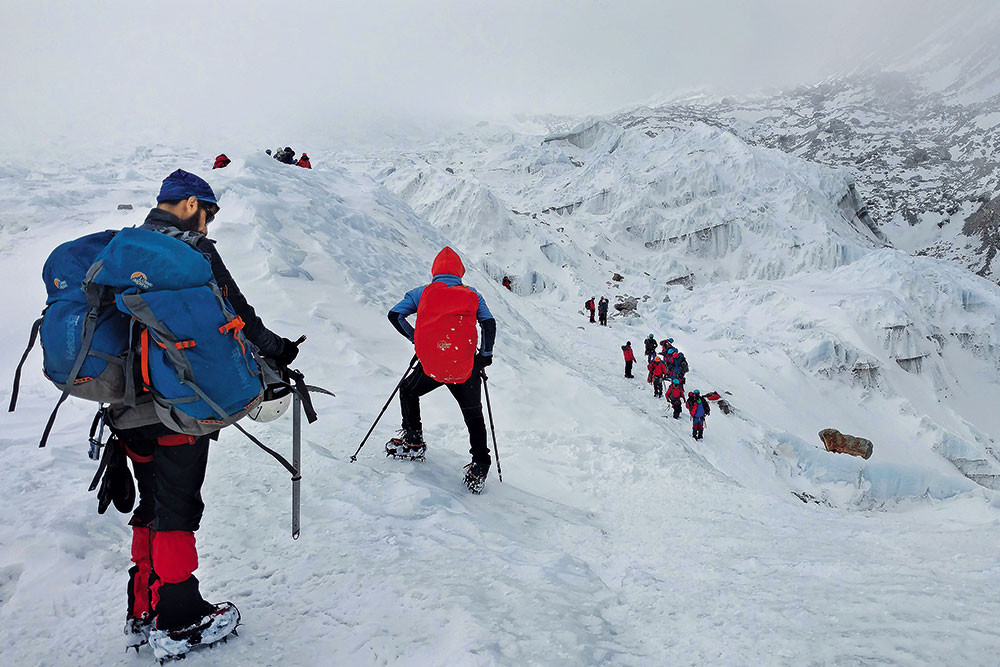For six months of the year, Aman G., 44, a marine engineer by profession, sails on the high seas and goes wherever his tanker or cargo takes him. Of the remaining six months he is on land, Aman spends at least a month in the mountains, which he calls his second home.
Passionate about mountaineering and adventure sports, he did a Basic Mountaineering Course (BMC) from the Himalayan Mountaineering Institute, Darjeeling, a premier mountaineering institute in India, in March 2017. A few years later, he climbed Mt Kun (7,077 metres) in the Zanskar valley in Ladakh.
Any adventure sport, especially mountaineering, is not for the faint-hearted. You need to overcome the fear of heights. Besides, ice climbing and glacier navigations require skills that are best learned at mountaineering institutes.
But developing the right attitude and skills is only a part of the story. To pursue a hobby like mountaineering, you also need deep pockets, as you will need appropriate clothes, boots, and other personal items, and special equipment such as karabiners, harnesses, and ice axes (See Tools Of Trade).
We spoke to a few trekkers to find out the costs of day hikes, treks, and expeditions for various durations and challenges, based on their personal experience.
Day Hikes
This is the most basic form of outdoor exploration, which even amateurs can attempt. Understandably, this is also the cheapest in the chain. For such a hike, you would need a small knapsack, some food and water, perhaps a flashlight, a pocket knife, and a walking pole, depending on where you take the hike.
Says Manish Pillai, 45, a Delhi-NCR-based software professional, who took to outdoors and trekking as a serious hobby around 2016 as part of a fitness regimen: “I went on my first day hike with a mountaineer friend, near McLeodganj, in 2009. He took me up to Triund through an alternate route via Bhagsu Nag, teaching me the basics of navigation. He was carrying a small tarp sheet that he pitched for our night shelter. My overall cost for the hike was maybe Rs 800, including the daypack I bought, food packets we carried, and the snacks and tea we had at a shepherd’s hut.”
Amateur trekkers should ideally go on day hikes on well-known and defined routes and let others know the intended duration and direction of the hike so that a search can be organised should they fail to return within a reasonable time. There have been multiple reports of day hikers getting lost in the wilderness as they usually lack survival skills of navigation, shelter-building or finding water. Also, they may find it difficult to set up a bivouac for a night in the wilderness.
Beginner And Medium Treks
After having done a few day hikes, you may graduate to treks, which are somewhere between day hikes and expeditions. Treks are relatively easy on the body, mind, and pocket compared to expeditions. Beginner and medium-level treks are perfect for exploring the outdoors as a serious hobby. A beginner-level trek with an agency could cost Rs 8,000-10,000, depending on the services offerred.
Says Aneesh Bhasin, 40, a Delhi-NCR based software professional, who has been going on off-beat treks with close friends every year since he began hiking in 2012: “On my first trek, I didn’t have a rucksack, sleeping bag, liner, or windproof jacket of my own. I paid Rs 7,000 to the agency and they provided me with all the gear. I carried my own luggage, but porters were available for another Rs 5,000.”
Later, he bought his own rucksack, sleeping bag, jackets, and boots, as it was better to do a one-time investment. He also purchased a harness, ice axe, snow crampons, and a few karabiners.
“Some high-altitude trek involves walking across snow fields and ridges. Although agencies, typically, provide snow crampons and also rope the team for safety, it’s better to have one’s own ice axe,” says Bhasin.
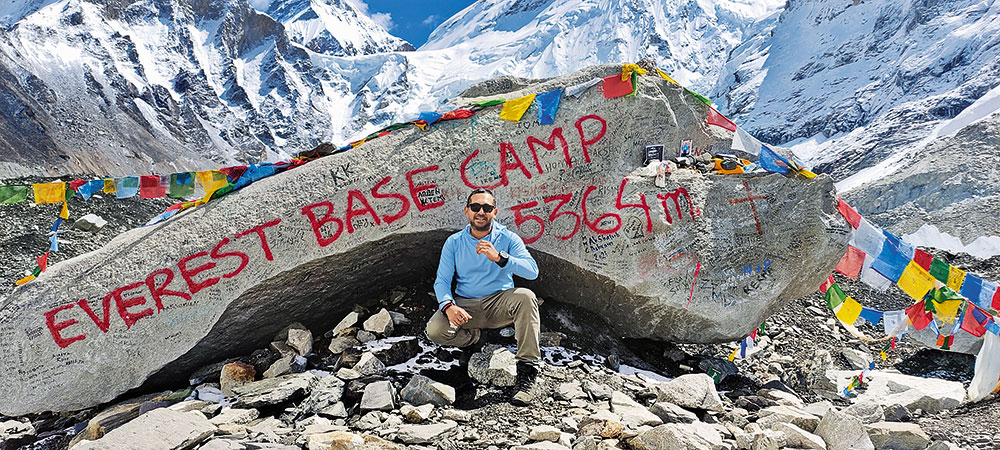
Aman G. at Everest Base Camp, Nepal. Photo: Aman G
Most mountaineering gear are made by French, Italian, or American companies, such as Petzl, Camp, or Black Diamond, respectively, and are expensive. The trekking equipment cost him around Rs 30,000, and the ice equipment a further Rs 10,000. But these are one-time costs, he says.
His investment proved worthy when he went on an uncharted trek with a few friends through a boutique agency that did not offer guides or equipment. “It was more of an exploration, and I paid only Rs 13,000 for the 7-day trek because I did not rent any gear,” he says, adding that some agencies charge less if participants bring their own gear.
Besides, there’s the added safety and assurance of not using common and possibly contaminated gear in this era of Covid, he adds.
Expeditions
The next step in the adventure trail is expeditions, which can be undertaken only by trained mountaineers or experienced trekkers (for non-technical peaks). These include mountaineering feats involving ascents and descents of peaks and summits of, say, Mt Everest, Kanchenjunga, Nanda Devi, etc. Long-duration treks could also be classified as expeditions because of the skill and endurance required to undertake them. For example, Parang La in Spiti Valley, Auden’s Col in Uttarakhand, and an alpine-style climbing (where climbers carry their own food, shelter and equipment) to Stok Kangri in extreme winter would classify as expeditions.
Says Aman: “I paid around Rs 1 lakh for the expedition to Mt Kun. The cost included lodging and food in Leh, meals during the expedition, equipment, and permits. The equipment included mountaineering boots, rope, helmet, ice axe, harness, crampons, descenders, jumars, karabiners, tents, sleeping bags, oxygen cylinders, and so on.”
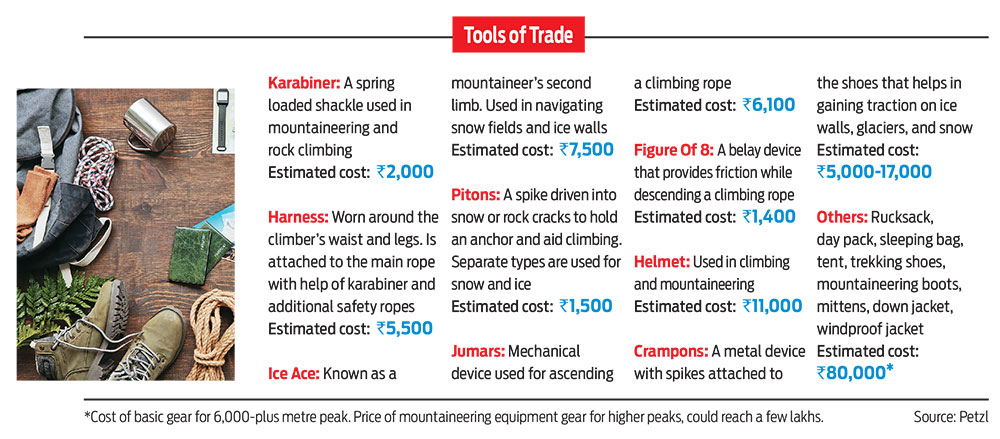
Aman carried his own rucksack and clothing gear. But these are available on hire too. For any 8,000-metre expedition though, you would likely hire the entire clothing gear because spending a fortune on a one-time adventure may not be financially viable.
The costs will also escalate every time you take on a bigger challenge. For example, the kind of boots, jackets, and gloves you would wear while climbing a 7,000-metre peak would be ineffective while going on an expedition on any of the 8,000 metre-plus peaks because of the extreme weather. Jackets, mittens, boots, and gloves are graded according to their weather-resistance capacity. For instance, the temperature at Everest could go down to -25°C (Celsius). Add the wind chill factor, and it will drop to -50°C or even less. In comparison, the temperature at Mt Kun might be -25°C (data according to mountain-forecast.com.)
An expedition to Mt Everest or any 8,000-metre peak would easily set you back by a minimum of Rs 25-30 lakh. This includes clothing gear, a four-season expedition category tent that can withstand high wind, low- and high-altitude porters, sherpas, personal gear, oxygen cyliders and permits. Should you attempt a solo expedition to, Mt Everest, with personal sherpa guides and porters, it can stretch up to Rs 70-80 lakh or even Rs 1 crore, according to data from summitclimb.com, an agency in Nepal which organises Everest Expedition.
Solo Treks
Mt Everest may not be within your means, but a trek to Everest Base Camp may be more affordable. Agencies in Nepal, on average, charge around Rs 60,000 for a trek to Everest Base Camp (ex-Kathmandu). Some charge less, but that could mean more participants and less quality service.
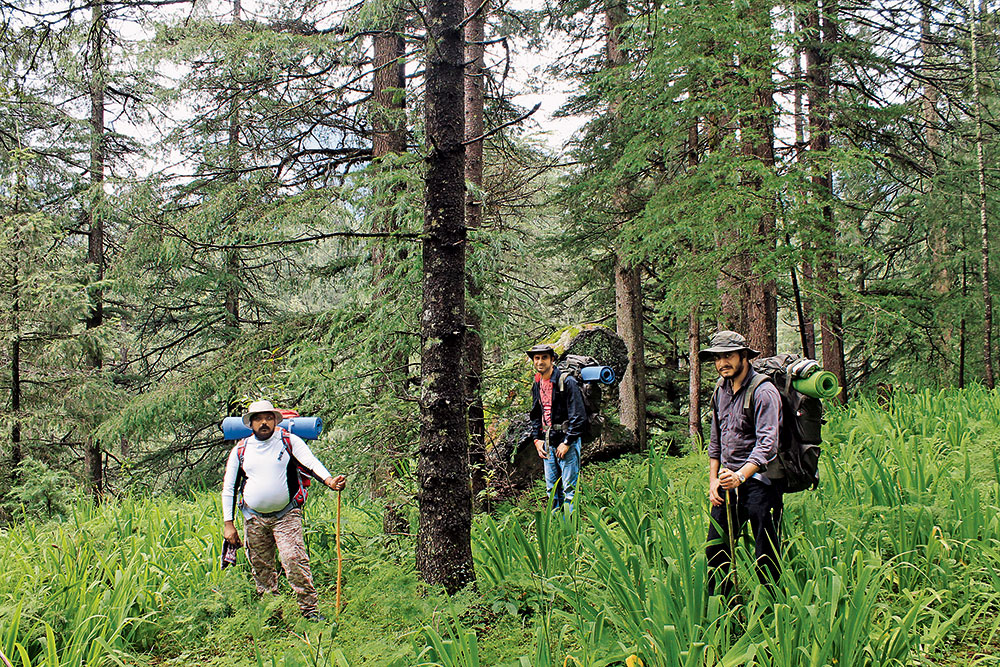
Manish Pillai (left) at the Great Himalayan National Park, Himachal Pradesh
Says Aman: “I did a five-day solo trek (without guide or support) to Everest Base Camp this September. I spent around Rs 60,000 ex-Chennai, including my airfare to Delhi, Kathmandu, and back. He says he was able to shorten the trip by four days as he is a trained mountaineer. He went during the off-season, which made his trek cheaper. The tariffs are relatively economical before Namche Bazaar on the trail to the Everest Base Camp. A room is available for Rs 150-200 per night, and food costs around Rs 600 for the entire day. “After Namche Bazaar, the food and lodging become very expensive. But I went during the off season. So, the teahouses only charged me for the food, and lodging was free (which would have otherwise cost Rs 3,000),” he says. The price of basic food and water proves how expensive the trek is. Aman paid Rs 300 for a bottle of water and Rs 650 for a bowl of fried rice at Gorakshep before Everest Base Camp.
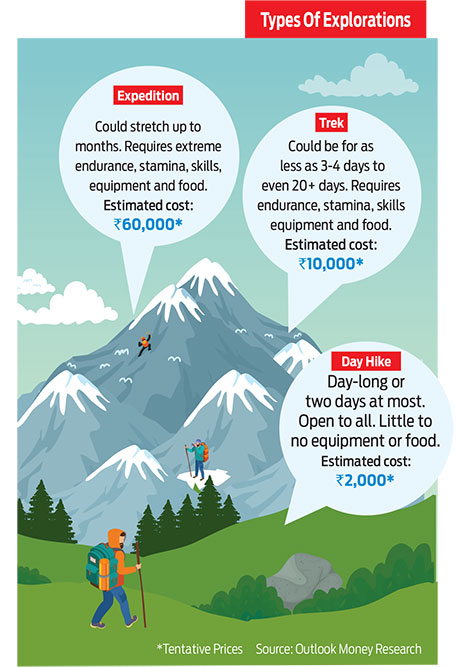
Mountaineering and trekking are hobbies that require grit and passion. Only long-term patience and rigour can get you to the summit you have dreamed of ascending. But to get there, you need to ensure you not only have the requisite skills, but also the necessary financial resources to scale the peaks.
s.sanyal@outlookindia.com

